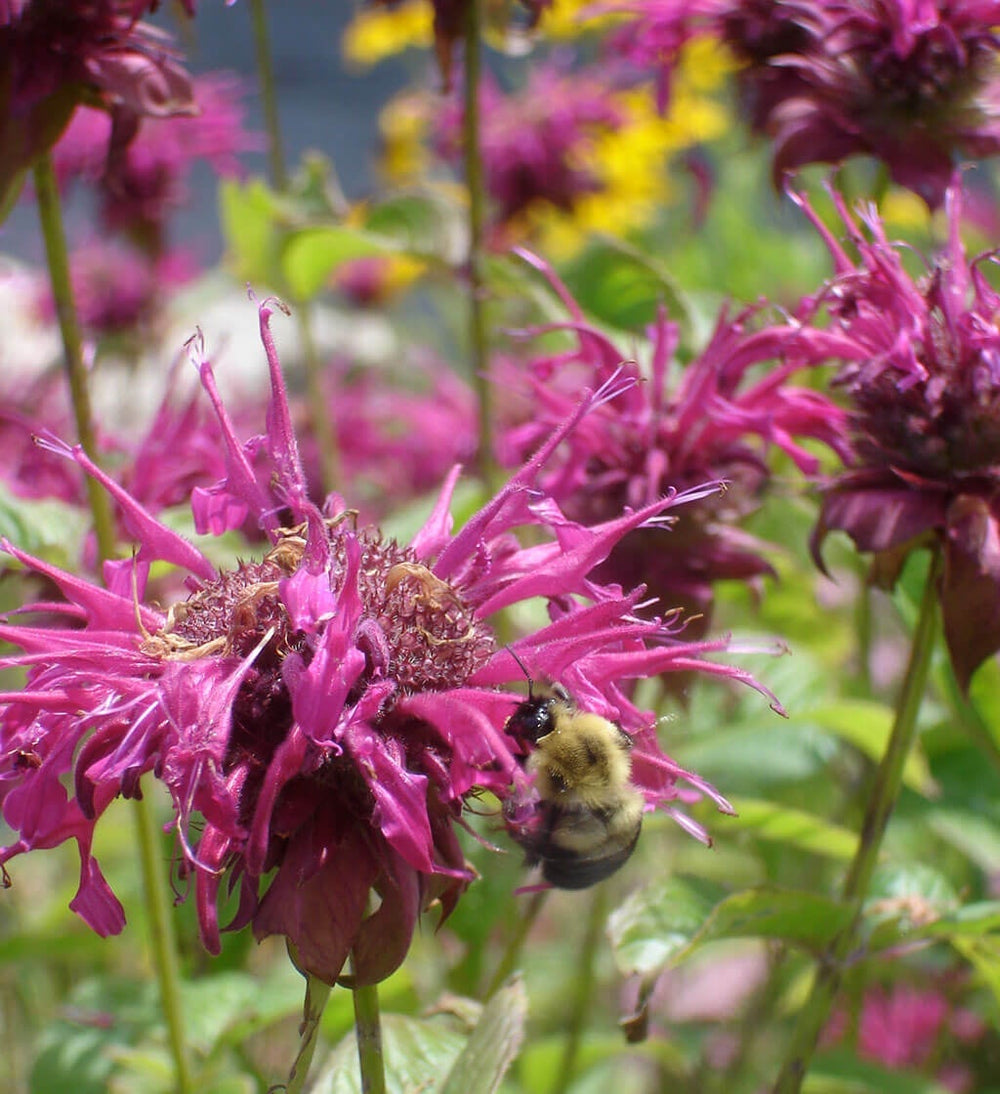Add bee balm to flower beds or an herb garden for life and color. Try growing bee balm in view of a window so you won't miss the acrobatics of hummingbirds that visit in summer. Bee balm also attracts butterflies and bees. In a sunny field or meadow, let plants spread and multiply to create a blanket of color.
Quick Guide to Growing Bee Balm
- Plant bee balm in spring or fall, once all chances of frost have passed.
- Space bee balm plants 18 to 24 inches apart in an area with full sun and fertile, well-drained soil with a pH of 6.0 to 6.7.
- Improve native soil by mixing in several inches of aged compost or other rich organic matter.
- Bee balm can withstand a dry spell, but for best results, water whenever the top inch of soil becomes dry.
- Encourage big, beautiful blooms by feeding bee balm with a water-soluble plant food.
- Flowers can be enjoyed as decorations or as a gorgeous garnish in salads and desserts.
Soil, Planting, and Care
For prolific blooms, plant in full sun; in the South and Southwest, a little afternoon shade helps flowers last longer. Picking the flowers encourages a second round of blooms. For best results, start with strong, vigorous young bee balm plants from Bonnie Plants®, the company that has been helping home gardeners find success for over a century.
Space plants 18 to 24 inches apart in rich, well-drained soil with a pH from 6.0 to 6.7. Improve your native soil by mixing in a few inches of compost or aged compost-enriched Miracle-Gro® Performance Organics® All Purpose In-Ground Soil before planting. In addition to starting with great soil, you'll want to feed your bee balm to produce excellent growth. Apply a liquid fertilizer, such as Miracle-Gro® Performance Organics® Edibles Plant Nutrition, every week throughout the growing season to feed the soil as well as your plants.
Although it will tolerate drought, bee balm will do much better if it gets adequate moisture; however, protect it from poor drainage, especially in winter. Water when leaves wilt in dry weather. Mulch in the spring.
In the late fall, cut plants back to within several inches of the ground. For a bushier shrub, pinch the tips of the stems when new growth appears each spring.
Bee balm spreads but not as aggressively as other members of the mint family. Every 3 or 4 years, dig up and divide the plants. Discard the old center section and replant the outer roots and shoots.
Troubleshooting
Bee balm can get powdery mildew. To avoid mildew, plant where there is good air circulation and avoid overhead watering. Also, cut back plants in the fall, remove old stems, and clean up old mulch.
Harvest and Storage
Pick bee balm flowers in summer as they appear. You can cut whole stems of bee balm to enjoy the flowers in a vase. Pick flowers for drying just before they open.
Uses
Use fresh flowers as a garnish for green salads, fruit salads, cakes, or preserves. The aromatic leaves serve as a substitute for mint and can be dried for tea. Dried leaves and flowers are also useful in sachets and potpourri.



FAQs
How do I use bee balm in an herb garden?
Bee balm is a great perennial for the flower garden, and a favorite of bees and hummingbirds as well as gardeners. However, one of its alternative names is Oswego tea, most likely referring to the tribe in the area of New York who used it to make a beverage. It does make a nice tea, similar to mint tea. In fact, you can use it as you would mint, although the flavor is somewhat different. In addition, the flowers are a lovely addition to green salads, fruit salads, or as a garnish. If you are fond of making potpourri or herbal wreaths, bee balm is a good plant to have on hand for both fragrant foliage and colorful blooms.
My plants faded quickly after a heat wave. Are they done for the season?
Actually, you may be able to get a second bloom in autumn by cutting plants back halfway down the stem. Be sure they have adequate moisture and a light application of fertilizer. When they bloom in fall, the temperatures should be milder and the show longer lasting.
The leaves on my bee balm are brown and crisp. I watered. What happened?
The most common problem with bee balm is a foliage disease called powdery mildew. That is a good name for it, because the leaves look like they have been dusted with powder. Unfortunately, leaves will turn brown and drop or be deformed. If powdery mildew hits in summer, cut your plants back to about half their height and fertilize. They will grow back and hopefully bloom again in fall. If the disease strikes in autumn, rest assured that your plant will sprout again in spring with healthy leaves.




 Herbs
Herbs
 Vegetables
Vegetables
 Fruit
Fruit
 Flowers
Flowers
 Succulents
Succulents


